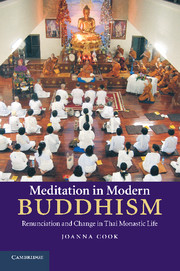Book contents
- Frontmatter
- Contents
- Acknowledgements
- List of map and figures
- Notes on language
- Map 1 Map of Thailand
- 1 Meditation and monasticism: making the ascetic self in Thailand
- 2 Meditation and religious reform
- 3 The monastic community: duty and structure
- 4 Meditation as ethical imperative
- 5 Language and meditation
- 6 Monastic duty, mindfulness and cognitive space
- 7 Money, mae chee and reciprocity
- 8 Hierarchy, gender and mindfulness
- 9 Monasticization and the ascetic interiority of non-self
- Appendix: Ordination transcript for an eight-precept nun (mae chee)
- Bibliography
- Index
7 - Money, mae chee and reciprocity
Published online by Cambridge University Press: 03 May 2011
- Frontmatter
- Contents
- Acknowledgements
- List of map and figures
- Notes on language
- Map 1 Map of Thailand
- 1 Meditation and monasticism: making the ascetic self in Thailand
- 2 Meditation and religious reform
- 3 The monastic community: duty and structure
- 4 Meditation as ethical imperative
- 5 Language and meditation
- 6 Monastic duty, mindfulness and cognitive space
- 7 Money, mae chee and reciprocity
- 8 Hierarchy, gender and mindfulness
- 9 Monasticization and the ascetic interiority of non-self
- Appendix: Ordination transcript for an eight-precept nun (mae chee)
- Bibliography
- Index
Summary
In this chapter I examine the part that women, in the ambiguous role of Buddhist nun (mae chee), are now taking in the emblematic Buddhist practice of alms donations. As we have seen, the monastic office of ‘mae chee’ is complicated. It is conveyed through the ritual adoption of religious vows and is usually undertaken for life. However, mae chee ordination is only partial and its status is far below that of monks. Because of this ambiguity mae chee are able to employ both the ascetic practices of renouncers (such as accepting alms) and those of lay women (such as offering alms). Mae chee, while debarred from the alms round in this monastery, both receive alms from the laity and donate alms to monks. Furthermore, mae chee receive monetary alms from the laity on behalf of the monastic community as a whole. In this chapter, I argue that by handling money given to the monastic community mae chee mediate in a relationship of generalized reciprocity between the monastic community and lay society. By donating alms to monks mae chee appear to be reaffirming their status of partial ordination, yet in order for them to be able to receive alms donations from the laity they must see themselves, and be recognized by the laity, as an integral part of the monastic community.
- Type
- Chapter
- Information
- Meditation in Modern BuddhismRenunciation and Change in Thai Monastic Life, pp. 135 - 150Publisher: Cambridge University PressPrint publication year: 2010



